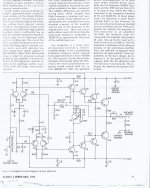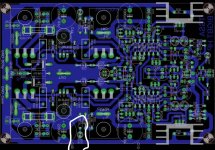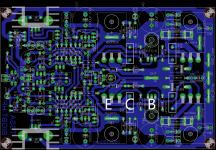Thanks bwaslo 🙂
If it's going to operate at 2A idle current the heatsink cannot hold that much heat generated , this is the reason why I avoided Class A 🙁 but I'd like to try my hands on point to point wiring but not on a Class A 😕
Thanks Sonnya
The basic circuit relies on high class A current. So to perform just decent it should operate at atleast 2A idle ... So rising the voltage to 40v means a lot of heat. Also the arrangement with collector into base of the output device with no basis to emitter Resistor to turn the power transistors fast off would mean slow turn of as soon as it leaves class A.
My tssa v2 to V8 is a lot more complex to keep it all running as you already had figured out. But Then it is possible to run it In class AB without sacrisfying Performance
Sent from my iPhone using Tapatalk
If it's going to operate at 2A idle current the heatsink cannot hold that much heat generated , this is the reason why I avoided Class A 🙁 but I'd like to try my hands on point to point wiring but not on a Class A 😕
Thanks Sonnya
Fully symmetrical amplifier
Good day folks so I am currently looking for information on a fully symmetrical amplifier. Attached is the topology that i am focusing on. All I have is the topology that was given to me and i am getting difficulties in finding the book where it was taken from, could anyone assist me?
Thanking you in advance!
http://www.diyaudio.com/forums/attachment.php?attachmentid=507819&stc=1&d=1444245430
Good day folks so I am currently looking for information on a fully symmetrical amplifier. Attached is the topology that i am focusing on. All I have is the topology that was given to me and i am getting difficulties in finding the book where it was taken from, could anyone assist me?
Thanking you in advance!
http://www.diyaudio.com/forums/attachment.php?attachmentid=507819&stc=1&d=1444245430
Attachments
Good day folks so I am currently looking for information on a fully symmetrical amplifier. Attached is the topology that i am focusing on. All I have is the topology that was given to me and i am getting difficulties in finding the book where it was taken from, could anyone assist me?
Thanking you in advance!
http://www.diyaudio.com/forums/attachment.php?attachmentid=507819&stc=1&d=1444245430
Hi
Symmetrical topology you are exploring is VFA which is not preferred in this thread. TSSA is CFA in CF output's configuration ie. voltage driven CCS. I would kindly ask if you can please proceed to find help in some other threads. Thanks for understanding.
Regards, L.C.

Good day folks so I am currently looking for information on a fully symmetrical amplifier. Attached is the topology that i am focusing on. All I have is the topology that was given to me and i am getting difficulties in finding the book where it was taken from, could anyone assist me?
Thanking you in advance!
http://www.diyaudio.com/forums/attachment.php?attachmentid=507819&stc=1&d=1444245430
May I suggest #7 - here - http://www.diyaudio.com/forums/solid-state/248105-slewmaster-cfa-vs-vfa-rumble.html
You might also want to reference - Leach Amp Plans - Part 1 "leachamp" = #7 (spooky) ....
OS
http://www.diyaudio.com/forums/W. Marshall Leach, Jr., Professor
Sorry to resurrect an old thread but to build the very first one lazycat posted- the bjt output version, with low low voltage (15v), what resistors need be changed and to what value?
That's a page from the now defunct Audio magazine.
It's from an article the LOW TIM Amp project by Marshall Leach of Georgia Tech.
I think in memorial to him, the amp web site is still up hosted by the university.
mlloyd1
It's from an article the LOW TIM Amp project by Marshall Leach of Georgia Tech.
I think in memorial to him, the amp web site is still up hosted by the university.
mlloyd1
Good day folks so I am currently looking for information on a fully symmetrical amplifier. Attached is the topology that i am focusing on. All I have is the topology that was given to me and i am getting difficulties in finding the book where it was taken from, could anyone assist me?
Thanking you in advance!
http://www.diyaudio.com/forums/atta...mmetrical-amplifier-symmetrical-amplifier-jpg
I would have a question if anyone has/could share a pdf layout or gerbers for making own TSSA BIGBT or TSSA 1.6 PCBs ?
Darek
Darek
No.. it doesn't work at all. I built it years ago.
that one is great
https://rpaudio.estranky.sk/fotoalbum/vssa/
that one is great
https://rpaudio.estranky.sk/fotoalbum/vssa/
The input stage used in the TSSA (up to V1.8) and First one for that matter, is flawed in a couple of ways.
It was supposed to be a shorter alternative to the Diamond buffer.
Thermally:
2. In normal cases. normal music signal it works as it should. If you go to clip or high frequency input, capacitors on emitter charge up. At a certain level the input pair will move to deep class B (shut off). It will exit class B with the timeconstant of discharge rate of the capacitors.... There is two capacitors.
It is nothing i say to harm any. It is just the case and it can be repeated by testing.
Best regards
Sonny
It was supposed to be a shorter alternative to the Diamond buffer.
Thermally:
- as heat builds up, the Vbe voltage drops as we all know with around 2.3mV/K. So 20 kelvins in temperature rise would mean a difference of 46mV. => 1K feedback resistors would mean current in collector to change with 46uA. It does not sound like not sound like a lot. It is is the start of the circuit though.. If that it not compensated is will mean a huge shift in bias current across temperature. Imaging from cold (20C) to hot of around 50C. Even use of lateral.
- A diamond buffer on the other hand is thermally compensated if transistors mechanical connected. With a heat shrink tube for example.
2. In normal cases. normal music signal it works as it should. If you go to clip or high frequency input, capacitors on emitter charge up. At a certain level the input pair will move to deep class B (shut off). It will exit class B with the timeconstant of discharge rate of the capacitors.... There is two capacitors.
It is nothing i say to harm any. It is just the case and it can be repeated by testing.
Best regards
Sonny
- Home
- Amplifiers
- Solid State
- TSSA - The Simplest Symmetrical Amplifier


